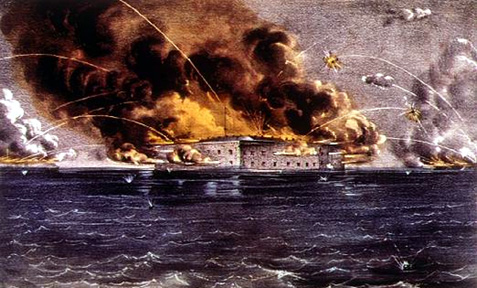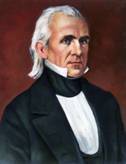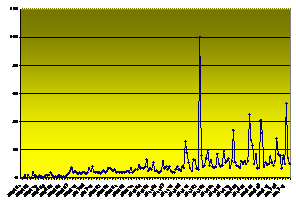False Flags — American as Apple Pie
“Events we may see as a bizarre and inexplicable
one-off’s are often, in fact, part of a pattern of organizational human
deception that goes back centuries.”
There have been numerous reports that the US is planning to attack North Korea in March after the end of the Winter Olympics in South Korea. Other reports
suggest the attack could come earlier. In either case, a casus belli
might take the form of a false flag. John Hamilton has examined the role
of false flags in US history and reports on three from the 19th
century.
By John Hamilton
America has been in the false flag business for a long time, and several anniversaries loom to remind us of the fact:
January 9, 1861: Ft. Sumter, an “innocent” re-provisioning or provocation to war?
February 2, 1845: Mexican War, “they might attack us, so we should attack them now”
February 15, 1898: USS Maine and The Spanish-American War, “Remember the Maine and to hell with Spain”
These historical events are worth reviewing at the present
moment, because they give us special insight into today’s headlines.
Events we may see as a bizarre and inexplicable one-off’s are often, in
fact, part of a pattern of organizational human deception that goes back
centuries.
The government plays chess, five steps ahead. The people
play checkers, if they play anything at all. Using misdirection, lies,
and deceit, the government inveigles the people to assume the desired
thoughts and actions that advance its agenda. These tools are as much a
part of a government’s arsenal as bombs and bullets.
Let’s briefly review each aforementioned event from the past, and show a modern counterpart.

(left, Ft. Sumter, like Pearl Harbour, a pretext for war.)
A close study of the Civil War shows it was fought for the
right of the federal government to collect heavy taxes from the South,
not for the abolition of slavery. As per usual, the investigative path
here is to “follow the money.” To keep that right to tax and the union
intact, Lincoln provided the incentive for the South to attack the
Union’s Ft. Sumter, thus creating a false flag as in “we were attacked”
vs. “we refused their overtures to make reparations and provoked them to
defend their territory.” This posture would ultimately win over
public opinion to its side, and make going to war possible.
Not everyone was fooled, however.
On April 16, 1861, the Buffalo Daily Courier
editorialized that “The affair at Fort Sumter . . has been planned as a
means by which the war feeling at the North should be intensified.
The New York Evening Day Book wrote on April 17, 1861,
that the event at Fort Sumter was “a cunningly devised scheme”
contrived “to arouse, and, if possible, exasperate the northern people
against the South.” “Look at the facts,” the Providence Daily Post
wrote on April 13, 1861. “For three weeks the [Lincoln] administration
newspapers have been assuring us that Fort Sumter would be abandoned,”
but “Mr. Lincoln saw an opportunity to inaugurate civil war without
appearing in the character of an aggressor.” (these quotes from The Real Lincoln by Thomas DiLorenzo).
In short, the entire operation was a false flag, a misdirection, a deceit.
Eventually, the Civil War would cost 620,000 lives, two
percent of the U.S. population. The engineer of the conflict, Lincoln,
lost his life as well. His famous assassin, the actor John Wilkes
Booth, shouted, “Sic semper tyrannis! (Ever thus to tyrants!) The South is avenged,” as he did his deed.
Modern counterparts to this event would include Pearl Harbor
and 9/11, events where the U.S. either invited attack or engineered an
attack on itself to catalyze a willingness to go to war on an otherwise
reluctant public.
THE MEXICAN WAR
Similarly, the Mexican War (1845) was a premeditated and provoked affair aimed at adding territory to the fledging U.S.

Conquering California, then part of Mexico, was an early goal of President James K. Polk (1845-1849).
Whether or not our neighbor, Mexico, provided provocation for
war — was irrelevant. They might be going to. That was enough to
launch a war.
Polk wrote in his diary (online as “The Diary of James K. Polk”),
“I stated to the cabinet that up to this time as they knew, we had
heard of no open act of aggression by the Mexican army, but that the
danger was imminent that such acts would be committed. I said that in
my opinion we had ample cause of war.”
George W. Bush was just following in these well-laid tracks
when he attacked Iraq March 20, 2003, based on the much-touted but never
located “weapons of mass destruction.” Of this offensive, writer Paul
Krugman said: “The Iraq war wasn’t an innocent mistake, a venture
undertaken on the basis of intelligence that turned out to be wrong.
America invaded Iraq because the Bush administration wanted a war.”)

USS Maine
On February 15, 1898, the USS Maine blew up in Havana harbor; 266 of the 355 sailors aboard were killed.
Without evidence, newspapermen Hearst and Pulitzer immediately blamed Spain and called for war. The New York Journal
headlined “Spanish Treachery.” “Remember the Maine, to hell with
Spain” would become the slogan. They had been beating the drum for war
and empire for a while. William Randolph Hearst’s New York Journal and Joseph Pulitzer’s New York World
either flat out invented numerous stories of Spanish atrocities on the
Cuban people, or mis-reported same in an effort to swing public opinion
against Spain.
President McKinley went to Congress to place a blockade of
Cuba on April 21. Spain declared war on the U.S. on April 23 and the
U.S. followed suit April 25th . The war lasted to August 12, and ended
with a U.S. victory. The Treaty of Paris (December 10, 1898) provided
for Spain to cede control of Cuba, The Philippines, Puerto Rico, Guam,
and parts of the West Indies.
One small fact: though the blast remained a mystery, Spain very likely did not blow up the Maine.
Investigators thought more likely a spontaneous combustion of
coal and/or coal dust sitting next to the magazine of ammunition in the
forward hull. They said the evidence supporting this was that the blast
blew outward from the hull and not inward as a mine would cause. Other
theories were advanced as well.
The Spanish never claimed responsibility for the blast. In
fact, their officials and civilians from the adjacent Spanish cruiser
Alfonso XII helped survivors. Some 100 lives were saved. For their
trouble, they got war.
This illustrates that a government will manipulate a tragedy
to its own end — whether it creates it or someone else does. In the
modern parlance: “never let a crisis go to waste.” Modern false flags
may be found in fake attacks by Germany (on Poland), Japan (on China)
and Russia (on Finland) used to start World War II.
In the modern day, deceptions and cover-ups come at us at an
increasing rate: JFK, 9/11, Las Vegas, and so many more. If you ever
wonder, would a government deceive or injure its own people to achieve
its goals, history tells us they’ve been doing just that for a very,
very long time.
The facts often sit in classified or redacted — or even
sealed — files. And not just in America — all over the world. The
informed citizen needs a working knowledge of these nefarious
machinations just to begin to understand the headlines on any given
day. Unvarnished truth may be the most scarce resource on the planet,
but the good news is we are seeing more and more whistleblowers,
investigators, and truth seekers take up the cause of mining it and
bringing it to the surface.
====================================================
John Hamilton’s career includes tours of duty in academia, business and government. His new book is False Flags, State Secrets, Government Deceptions: A Short History of the Modern Era. Available on Amazon.
NOTE

Google search for “false flag” peaked in April, 2013 in the
aftermath of the Boston Marathon bombing, and then again in October,
2017, in the aftermath of the Las Vegas Massacre. Which kind of
inexplicable event will be next? And what will be the real story behind
it?
Ole Dammegard "Assassinations, Fake News & False Flags"
SOURCE

No comments:
Post a Comment